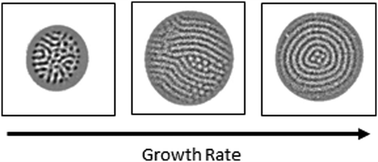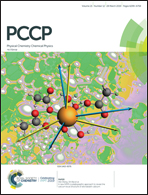Turing patterns on radially growing domains: experiments and simulations†
Abstract
We study Turing pattern formation in a system undergoing radial growth in two dimensions. The photosensitive chlorine dioxide–iodine–malonic acid reaction is illuminated to inhibit patterning, with a growing non-illuminated circular domain in which the pattern develops. We examine the relationship between the linear radial growth rate and the resulting pattern morphology. Faster growth causes the pattern to form parallel to the growing boundary as concentric rings, while slower growth leads to pattern formation perpendicular to the growing boundary. We observe three distinct growth modes for the Turing patterns, which also depend on the radial growth rate. The experimental results are qualitatively reproduced in numerical simulations using the Lengyel–Epstein model with an additional term to account for the photosensitivity of the reaction. These results may provide new insight into how patterns form in growing biological systems.



 Please wait while we load your content...
Please wait while we load your content...